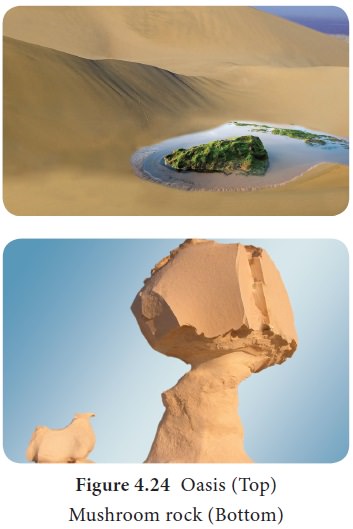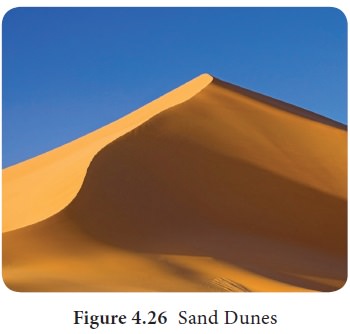Action of the wind, Erosional and Depositional Landforms of Wind - Wind | 11th Geography : Chapter 4 : Lithosphere: Exogenic Processes
Chapter: 11th Geography : Chapter 4 : Lithosphere: Exogenic Processes
Wind
Wind
The wind is the main geomorphic agent in the arid
region. Wind in arid region has greater speed which causes erosional and
depositional activities in the desert. The landforms which are created by
erosional and depositional activities of wind are called as Aeolian Landforms.
Action of the wind
The action of the wind is carried in the following
ways;
1.
Deflation: Removal of sand and dust particles by wind. It forms depression in the desert. When
depression is filled with water, it is called as Oasis.
2.
Abrasion: Action of wind in which sand particles carried by the wind strike against the rock.
3.
Attrition: Sand particles carried by the wind striking each other is known as attrition.
Erosional Landforms of Wind
1. Deflation Hollows
When deflation causes a shallow depression by
persistent movements of wind, they are called as deflation hollows.
2. Mushroom Rock
A mushroom rock, also called rock pedestal, or a
pedestal rock, is a naturally occurring rock whose shape, as its name implies,
resembles a mushroom.

In deserts, a greater amount of sand and rock particles are transported close to the ground by the winds which cause more erosion in the lower part of the rock than the top. These result in the formation of rock pillars shaped like a mushroom with narrow pillars with broad top surfaces.
3. Yardang
Yardangs are extensively grooved, fluted, pitted
and irregular rock ridges or reliefs of about 1 to 10 meters high running
parallel to the prevailing winds. They are caused by differential erosion. When
the sand-laden wind corrades zones of softer or weaker rock between harder
vertical ridges from old lake sediment where soft, consolidated rock and
bedrock surfaces are eroded into alternating ridges and furrows. Large-scale
yardangs are found in Egypt (near Kom Ombo, north of Lake Aswan).
Zeugen
Zeugen is a landscape of alternate horizontal
ridges and furrows made by the action of wind abrasion. It may be as high as 30
m height.

Depositional Landforms of Wind
1. Sand dunes
Dry hot deserts are good places for sand dune
formation. According to the shape of a sand dune, there are varieties of sand
dune forms like Barchans, Seif dune, etc. The barchan is one of the classic
desert landforms. It is a crescent-shaped dune with the horns of the crescent
stretching out in the leeward direction. Barchan dunes may reach more than 27
meter in height. Seif dunes are long ridges of sand. In general they are
aligned in the direction of the prevailing wind. The slip face of seif dunes
are probably formed by eddies. The depressions between seif dune ridges are
swept clear of sand by the winds. The ridges

2. Loess
In several large areas of the world, the surface is
covered by deposits of wind transported silt that has settled out from dust
storms over many thousands of years. These depositions are called as Loess.
3. Pediplains
When the high relief structures in deserts are
reduced to low featureless plains by the activities of wind, they are called as
Pediplains.
Related Topics